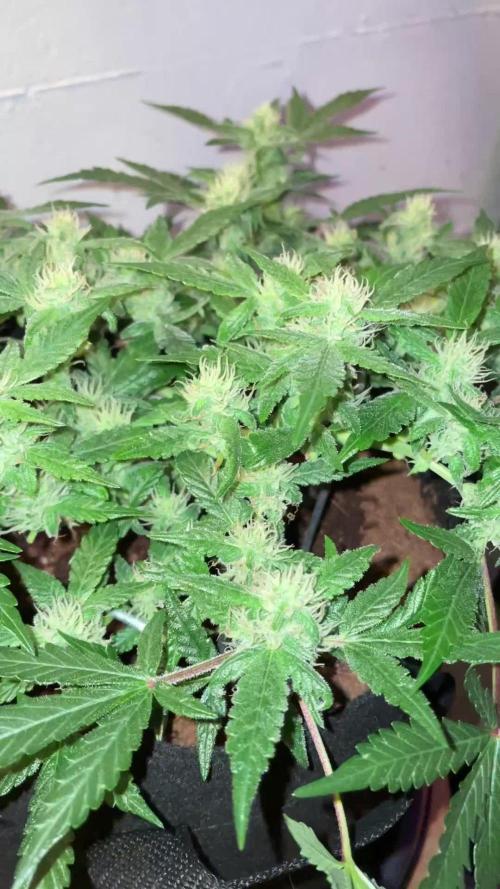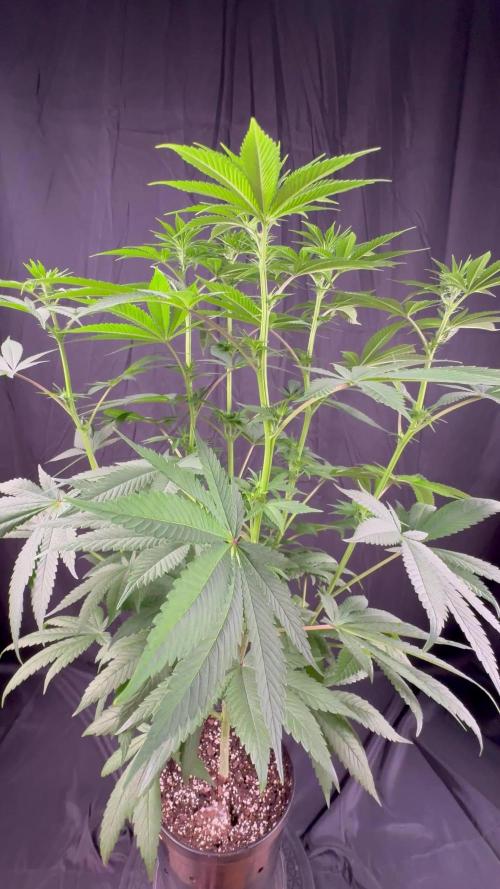The Grow Awards 2026 🏆 



































Likes
Comments
Share


@pifflestikkz
Follow
Day 175
04/04/25 Friday!!
So she now enters her 24hrs dark period.
Day 176
05/04/25 Saturday
Harvest time
Likes
17
Share


@Lazuli
Follow
This plant was grown in pure coco with 30% perlite, one watering a day untill runoff, at the mid flowering i water once every 12hours. She does get very bushy and puts on all the weight at the end of flowering so i was a bit worried first but she blew up
Likes
97
Share


@Kitties_and_Colas
Follow
~_~_~_~_~_~_~_~_~_~_~_~_~_~_~_~_~_~_~_~_~_~_~_~_~_~_~_~_~_~_~_~_~_~_~_~_~_~_~_~_~_~_~_~_~_~_~_~_~_~_~_~_~_~_~_~_~_~_~_~_~_~_~_~_~_~_~_~_~_~_~_~_~_~_~_~_~_~_~_~_~_~_~_
❤️💡🌱😽💨
Week 4! We're about 1/3rd the way through flower..these girls are getting really frosty for their age. There's still some yellowing from almost killing them 1.5weeks ago but they've almost full recovered from our neglect. Nodes have a great distance, its growing similar to our White Widow under the SP-3000..I suspect long 6 long colas on each plant a couple with some side growth we decided to keep. Not too much else to report, we're still babying these girls after our blunder but they seem to be on track now..Thanks for dropping by and happy harvests everyone!!
⚡Mars Hydro/SP-3000⚡ Specifications ⚙️:
Diodes: Samsung LM301B / Osram 660nm (960 total!)
Driver: Meanwell 300watt 🔌 (300W±5% @AC120V-277V)
PPF: 824umol/S ☢️
PPE: 2.8 µmol/j 〰️〰️
Lifespan: 50k+ hrs ⌛
Weight: 10.1 lbs (4.6kg)
Veg Coverage: 3 x 5 ft 🌱
Flowering Coverage: 2 x 4 ft 🌼
-The SP-3000 uses an aluminum heatsink (no fan) and the driver can be placed outside the tent 🌡️⬇️
-IP65 waterproof ratings, tolerant to high humidity grow environments 💦 ..
-Up to 15 can be daisy-chained together and all controlled from a single light! 💡~💡~💡~💡~💡
~_~_~_~_~_~_~_~_~_~_~_~_~_~_~_~_~_~_~_~_~_~_~_~_~_~_~_~_~_~_~_~_~_~_~_~_~_~_~_~_~_~_~_~_~_~_~_~_~_~_~_~_~_~_~_~_~_~_~_~_~_~_~_~_~_~_~_~_~_~_~_~_~_~_~_~_~_~_~_~_~_~_~_
Likes
5
Share


@deepsheeba
Follow
Corrected the nutrient ratio to 120-20-100 ppm.
Plant is still stretching and I'm waiting she start fattening.
Two sanlight are going to be implemented for a CO2 heavy growing
Processing
Likes
17
Share


@CanadaGrows
Follow
Growing in rockwool slabs, just moved them from starter cubes to final after a few days.
Hand water under 400w HPS
5 autoflowers
- 3 purple kush
- 1 blue dream
- 1 tangerine dream
Tent is 4x2x5
Likes
15
Share


@GroLife
Follow
First week of flowering was interesting, started scrOG training looks like I’m exposing the plant to grow more cola’s crossing my fingers on this. The aroma of the plant is starting to get stronger.
Likes
5
Share


@Kardo
Follow
Die Blueberry hat überall schön viel Zucker gebildet und die buds sind schön dick ich bin mal gespannt wie die Ernte aussieht wenn sie fertig ist
Processing
Likes
6
Share


@Alejangrow
Follow
3 more weeks of veg then gonna throw them all into flower. 🌺
These are definitely coming along nicer than my last widow run.😅
Gonna do a little lollipopping on these this week & a little defoliating in the process. 🍭
Processing
Likes
7
Share


@Yukagrls
Follow
She is growing healthy and strong. I turned her around a little bit, because they start moving around and I read that is good for them. I hope the pictures can show how fast she is growing. :)
Likes
17
Share


@DudeGrowsWeed
Follow
5’-2” & 4’-6”!! Growing like weeds!🤣👍💪 Loving being outdoors and the high temperatures we’ve been having! Supplemental Recharge and Cal/Mag added once per week.
Likes
22
Share


@BruWeed
Follow
☘️04/11 - Empieza su tercera semana en Etapa de crecimiento.
☘️Su crecimiento es muy notorio de una semana a otra, esta creciendo fuerte y su desarrollo es muy bueno. Esta creciendo de forma correcta sin ningún problema.
☘️Este diario es para participar en el sorteo de "Best Rarest & Smallest Pot by seedman".
☘️Esta es su última semana en Etapa de crecimiento, ya el 09/11 comienza en Floración.
☘️Estos días seguiré subiendo más imágenes de como viene.
Likes
141
Share


@bioaccessory
Follow
Не знаю как вы, а я очень люблю этот день - день сбора урожая. И это даже несмотря на то, что в этот день приходится маникюрить срезанные кусты(я предпочитаю делать это до сушки). В этот раз триммить было особенно сложно, много мелких сативных листочков росло прямо из шишек. А что там шишки? Да супер, твердые как камень, всё как я хотел🌿!
В день харвеста(вовремя, спасибо Джа!) не выдержала моя техника - отключилась половина лампы(на 1видео 19с.), видимо действительно пришло время.
🗓️Друзья мои, всех приглашаю в мой дневник через 10 дней сушки, буду взвешивать и пробовать урожай, подводить итоги👆
Спасибо, что заглянули, и будьте здоровы! 🙏
Продолжение следует ...😶
Likes
31
Share


@Chubbs
Follow
SuperSativaSeedClub
PurplePunchOG Auto
Week 13
Weekly update on these two amazing ladies. This week I had some temperature swings from cold to hot but all in all they handled it like Champs. I checked the trichs today and only seeing mostly cloudy on the bigger one with still clear and cloudy on the one thats LST. I'll check later this week as I'm shooting for a 90/10 cloudy to amber. All in all Happy Growing.
Likes
27
Share


@valiotoro
Follow
Pheno 1 dark purple : On the nose, it reveals a sharp burst of fresh lemon, layered with a powerful eucalyptus aroma that’s both invigorating and camphorous. A truly refreshing and vibrant terpene profile😈🍋
Pheno 2 Green : this one is a real surprise! If I close my eyes, it’s like Nutella! It’s as if you’ve just walked into a kitchen where hazelnuts have been freshly roasted 🤤🌰
Pheno 3 light purple : It’s a mix of the first two with a hint of amarena cherry at the end🍒🍧
Likes
75
Share


@Dedon
Follow
Hi everyone !
Everything is ok, no disease, no carrency. 👌
they start to smell a little and pistils appear everywhere 😍
i change the nutrient solution and start with PK 13/14
See you next week ;)
Likes
11
Share


@AGrowerNotAShower
Follow
Start of Week 11 - Day 71
07/12: It seems as if Annie’s stretch is slowing down. She’s now at about 30” tall and she has a lot of colas poking out from her base. Aaliyah and Alexis have stopped their height at 34”. Alexis’s buds are starting to get bigger. The buds in Aaliyah’s main cola are starting to connect and are also getting bigger. Aaliyah’s bigger buds are also getting coated in trichomes. The smell is still pretty minimal. Based on the visual changes it appears that Alexis is about a week behind Aaliyah and Annie is about three weeks behind Aaliyah. Since this is my first grow I’m not too sure on harvesting time, but I’d say Aaliyah will be ready first and she still has a few weeks left in her. They are losing some leaves closer to the base, but they are looking amazing overall. It’s hard to believe it’s been 70 days since I put the seeds in water. Time really flies.
07/16: Playing the waiting game and it isn’t easy, but it will be worth it. The ladies are at different stages of flowering, so I’ve decided that next week I’m going to start giving them different doses of nutrients.
Likes
27
Share


@Zamzam974
Follow
Salut les cultivars sa roule ?!
C+29 a C+38 début floraison je pense... Sa pousse bien. Bonne vigueur des autofloraison surtout la critical... Arrosage tous les 3 4 jours 1litre par pot apport de mélasse à chaque arrosage... J'ai jouter deux ampoule une Led de 15w et cfl de 23w équivalente à une 100w la Led fait 4000k 1500lumens et la cfl 2700k 1500lumens la plante transpire pas mal mai pas de souci de moisissures... J'installe la cfl 250w 2700k quand la floraisons sera bien démarrer... Tous conseils sont les bien venu merci je c'est pas si je vais a 12/12 pour la wombat qui est féminisé pour ne pas perdre en quantité sur les auto qui et mieux 18/6 sinon bouturage pour la wombat je suis dans l'impasse total pour le moment 🙄
Likes
5
Share


@Ninjabuds
Follow
El dorado og has some old school genetics to is and they are starting to shine. It’s really starting to stack up the stems real nicely. The plant reaks like skunk. I bet it turns out really nice
All of the plants have really taken off. Usually I have a couple plants that are much smaller but all of these plants are getting huge. Seeing I got a new eluefah uap1500 the other day and I have my 2 fastbuds plants under that now I have my spider farmer light free. So I popped up another 2x2 and moved 3 of the 10 plants into the 2x2 and left the 7 other in the 2x4.




















